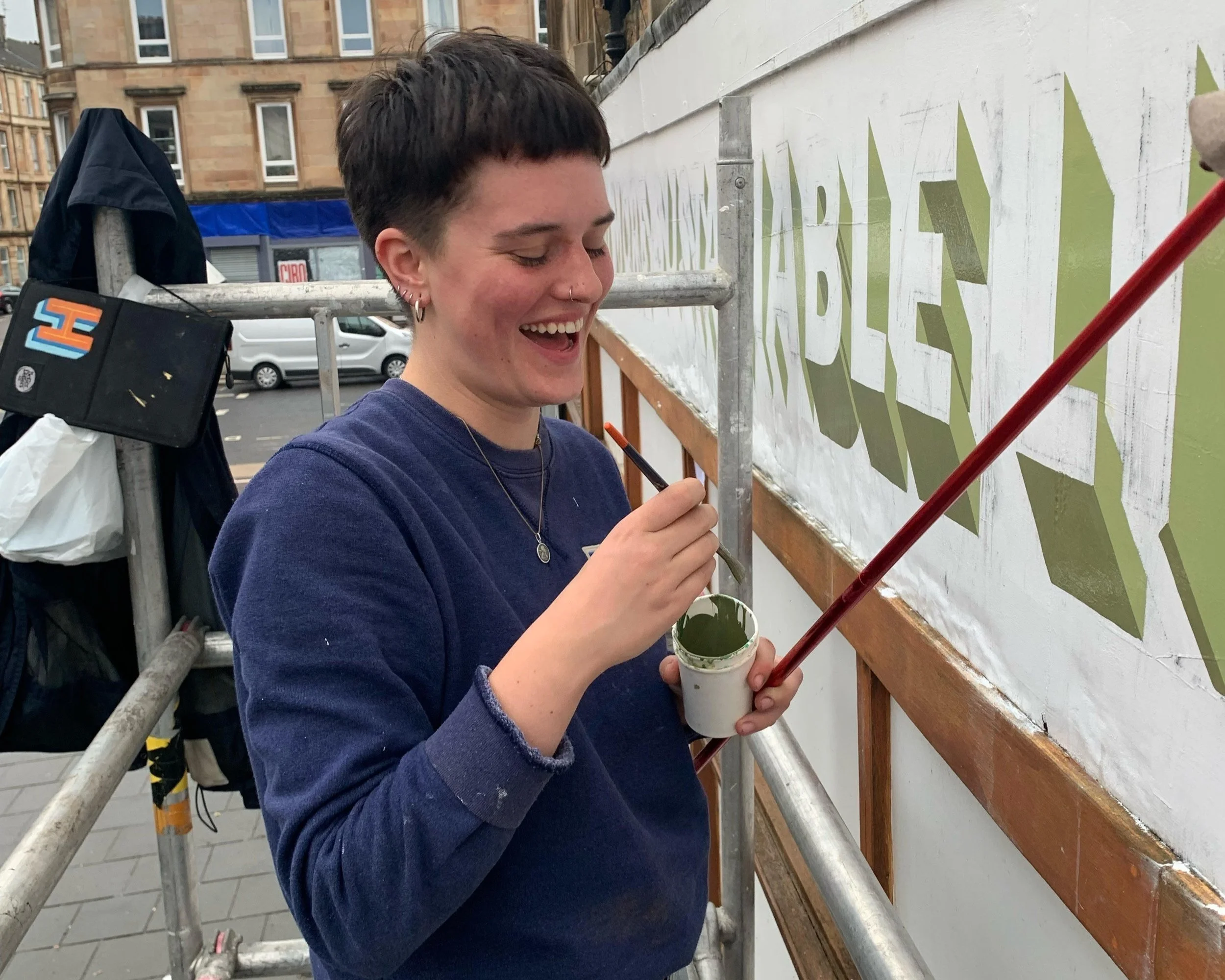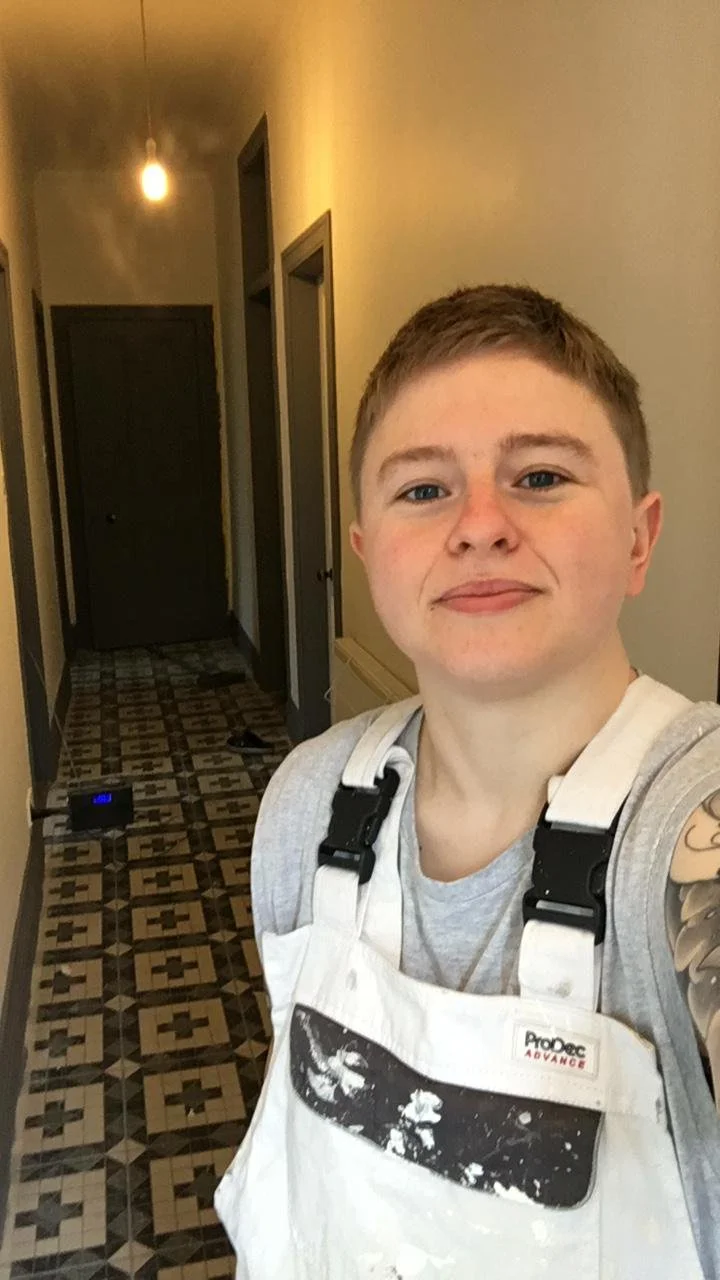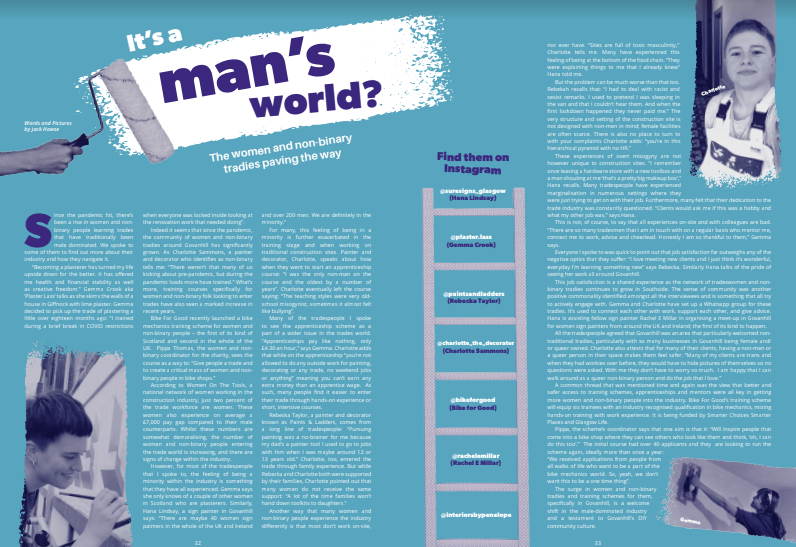It’s a Man’s World? : The Women and Non-Binary Tradies Paving the Way
Since the pandemic hit, there’s been a rise in women and non-binary people in and around Govanhill learning trades that have traditionally been male dominated. For Issue 5 of the magazine, we spoke to some of these tradespeople to find out more about their industry, how they navigate it.
Photo courtesy of Hannah Lindsay
By Jack Howse
“Becoming a plasterer has turned my life upside down for the better. It has offered me health and financial stability as well as creative freedom.” Gemma Crook aka ‘Plaster Lass’ talks as she skims the walls of a house in Giffnock with lime plaster. Gemma decided to pick up the trade of plastering a little over eighteen months ago: “I trained during a brief break in COVID restrictions when everyone was locked inside looking at the renovation work that needed doing”.
Indeed it seems that since the pandemic, the community of women and non-binary tradies around Govanhill has significantly grown. As Charlotte Sammons, a painter and decorator who identifies of non-binary tells me: “There weren’t that many of us kicking about pre-pandemic, but during the pandemic loads more have trained.” What’s more, training courses specifically for women and non-binary folk looking to enter trades have also seen a marked increase in recent years.
Bike For Good recently launched a bike mechanics training scheme for women and non-binary people – the first of its kind of Scotland and second in the whole of the UK. Pippa Thomas, the women and non-binary coordinator for the charity, sees the course as a way to: “Give people a trade and to create a critical mass of women and non-binary people in bike shops.”
According to Women On The Tools, a national network of women working in the construction industry, just two percent of the trade workforce are women. These women also experience on average a £7,000 pay gap compared to their male counterparts. Whilst these numbers are somewhat demoralising, the number of women and non-binary people entering the trade world is increasing, and there are signs of change within the industry.
However, for most of the tradespeople that I spoke to, the feeling of being a minority within the industry is something that they have all experienced. Gemma says she only knows of a couple of other women in Scotland who are plasterers. Similarly, Hana Lindsay, a sign painter in Govanhill says: “There are maybe 40 women sign painters in the whole of the UK and Ireland and over 200 men. We are definitely in the minority.”
Photo courtesy of Charlotte Sammons
For many, this feeling of being in a minority is further exacerbated in the training stage and when working on traditional construction sites. Painter and decorator, Charlotte, speaks about how when they went to start an apprenticeship course: “I was the only non-man on the course and the oldest by a number of years”. Charlotte eventually left the course because they found: “The teaching styles were very old-school misogynist, sometimes it almost felt like bullying”.
Many of the tradespeople I spoke to see the apprenticeship scheme as a part of a wider issue in the trades world. “Apprenticeships pay like nothing, only £4.30 an hour,” says Gemma. Charlotte adds that while on the apprenticeship “you’re not allowed to do any outside work for painting, decorating or any trade, no weekend jobs or anything” meaning you can’t earn any extra money than an apprentice wage. As such, many people find it easier to enter their trade through hands-on experience or short, intensive courses.
Rebecka Taylor, a painter and decorator known as Paints & Ladders, comes from a long line of tradespeople. “Pursuing painting was a no-brainer for me because my dad’s a painter too!” she tells me. “I used to go to jobs with him when I was maybe around 12 or 13 years old.” Charlotte, too, entered the trade through family experience. But while Rebecka and Charlotte both were supported by their families, Charlotte pointed out that many women do not receive the same support: “A lot of the time families won’t hand down toolkits to daughters.”
Another way that many women and non-binary people experience the industry differently is that most don’t work on-site, nor ever have. “Sites are full of toxic masculinity,” Charlotte tells me. Many have experienced this feeling of being at the bottom of the food chain, “they were explaining things to me that I already knew” Hana told me.
But the problem can be much worse than that too. Rebekah recalls that: “I had to deal with racist and sexist remarks. I used to pretend I was sleeping in the van and that I couldn’t hear them. And when the first lockdown happened they never paid me.” The very structure and setting of the construction site is not designed with non-men in mind; female facilities are often scarce. There is also no place to turn to with your complaints Charlotte adds: “you’re in this hierarchical pyramid with no HR.”
These experiences of overt misogyny are not however unique to construction sites. “I remember once leaving a hardware store with a new toolbox and a man shouting at me ‘that’s a pretty big makeup box’,” Hana recalls. Many tradespeople have experienced marginalisation in numerous settings where they were just trying to get on with their job. Furthermore, many felt that their dedication to the trade industry was constantly questioned. “Clients would ask me if this was a hobby and what my other job was,” says Hana.
This is not, of course, to say that all experiences on-site and with colleagues are bad. “There are so many tradesmen that I am in touch with on a regular basis who mentor me, connect me to work, advise and cheerlead. Honestly I am so thankful to them,” Gemma tells me.
And, everyone I spoke to was quick to point out that job satisfaction far outweighs any of the negative optics that they suffer: “I love meeting new clients and I just think it’s wonderful, everyday I’m learning something new” says Rebecka. Similarly Hana talks of the pride of seeing her work all around Govanhill.
This job satisfaction is a shared experience as the network of tradeswomen and non-binary tradies continues to grow in Southside. The sense of community was another positive commonality identified amongst all the interviewees and is something that all try to actively engage with. Gemma and Charlotte have set up a Whatsapp group for these tradies. It’s used to connect each other with work, support each other, and give advice. Hana is assisting fellow sign painter Rachel E Millar in organising a meet-up in Govanhill for women sign painters from around the UK and Ireland; the first of its kind to happen.
All the tradespeople agreed that Govanhill was an area that particularly welcomed non-traditional tradies, particularly with so many businesses in Govanhill being female and/or queer owned. Charlotte also attests that for many of their clients, having a non-man or a queer person in their space makes them feel safer. “Many of my clients are trans and when they had workies over before, they would have to hide pictures of themselves so no questions were asked. With me they don’t have to worry so much. I am happy that I can walk around as a queer non-binary person and do the job that I love.”
A common thread that was mentioned time and again was the view that better and safer access to training schemes, apprenticeships and mentors were all key in getting more women and non-binary people into the industry. Bike For Good’s training scheme will equip six trainees with an industry recognised qualification in bike mechanics, mixing hands-on training with work experience. It is being funded by Smarter Choices Smarter Places and Glasgow Life.
Photo by Jack Howse
Pippa, the scheme’s coordinator says that one aim of the scheme is that it: “Will inspire people that come into a bike shop where they can see others who look like them and think, ‘oh, I can do this too’.” The initial course had over 40 applicants and they are looking to run the scheme again, ideally more than once a year: “We received applications from people from all walks of life who want to be a part of the bike mechanics world. So, yeah, we don’t want this to be a one time thing”.
The surge in women and non-binary tradies and training schemes for them, specifically in Govanhill, is a welcome shift in the male-dominated industry and a testament to Govanhill’s DIY community culture.
Find them on Instagram:
@suresigns_glasgow (Hana Lindsay)
@plaster.lass (Gemma Crook)
@paint_and_ladders/(Rebecka Taylor)
@charlotte_the_decorator (Charlotte Sammons)
@bikeforgood (Bike for Good)
@rachelemillar (Rachel E Millar)
This article was first published as part of Issue 5. To get yourself a copy of the Issue, and all past editions, follow the link at the top of this article.



